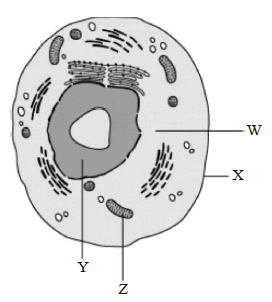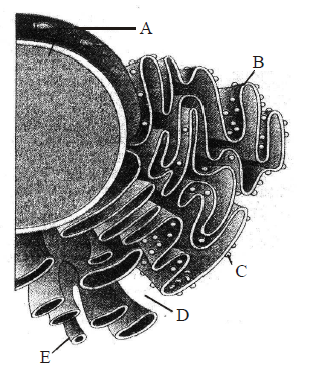_______________ is the important site of formation of glycoproteins and golycolipids.
SER
Lysosome
Golgi apparatus
Mitochondria
Correct Answer :
C. Golgi apparatus
The Golgi apparatus (also known as the Golgi complex, Golgi body) is an organelle, identified in 1897 by the Italian physician Camillo Golgi and named after him in 1898. Golgi apparatus is the important site of formation of glycoproteins and glycolipids. It functions as a factory in which proteins received from the ER are further processed and sorted for transport to their ultimate endpoints: lysosomes, the plasma membrane.
Related Questions
Which of the following cell organelles were discovered after the introduction of electron microscope?
Mitochondria
Endoplasmic reticulum
Ribosomes
Both (b) and (c)

Which cellular structure helps in transferring genetic information from one generation to another?
W
X
Y
Z
Axoneme with 9 + 2 microtubular arrangement occurs in
cilia
flagella
both (a) and (b)
centriole
Which of the following statement of a bacterial cell is/are correct?
- Mesosome is formed by the extensions of plasma membrane into the cell.
- The pili are elongated tubular structures made up of a protein.
- Flagellum is composed of filament, hook and basal body.
- Ribosomes are about 30 nm by 50 nm in size.
(i), (ii), (iii)
All of the above
(ii) & (iv)
None of the above
Microtubules are absent in
mitochondria
centriole
flagella
spindle fibres
Which of the following pair are correctly matched.
A. Microtubules Structural components of cilia
B. Centrioles Store hydrolytic enzymes
C. Amyloplasts Store oil protein and starch in plants
A, B and C
A and B
A
A and C
Select the incorrect statement about prokaryotic ribosomes.
50S and 30S subunits unite to form 70S ribosomes.
Polysome/polyribosome consists of many ribosomes only.
Ribosome is the site of protein synthesis.
Polysome indicate the synthesis of identical poolypeptide in multiple copies.
Match column I (cell type) with column II (size) and choose the correct option.
| Column-I | Column-II |
|---|---|
| (Cell type) | (Size) |
| A. Viruses | I. 1-2 ??m |
| B. PPLO | II. 10-20 ??m |
| C. Eukaryotic cell | III. About 0.1 ??m |
| D. Bacterium | IV. 0.02 - 0.2 ??m |
A I, B II, C III, D IV
A IV, B III, C II, D I
A I, B III, C II, D IV
A IV, B II, C III, D I
Extension of plasma membrane in prokaryotic cell is
mesosome
haploid
ribosome
none of these
Which one of the following combination is mismatched?
Glycocalyx May be capsule or slime layer
Pili Reproduction
Cell wall Protective, determines shape, prevents from bursting
Flagella, pili and fimbriae Surface structures of bacterial cell
Which of the following statements are incorrect ?
- Plant cells have centrioles which are absent in almost all animal cells.
- Ribosomes are the site of protein synthesis.
- The middle lamella is a layer mainly of calcium carbonate which holds the different neighbouring cells together.
- In animal cell, steroidal hormones are synthesized by smooth endoplasmic reticulum. Of the above statements
(i) and (iii)
(iii) and (iv)
(ii) and (iv)
(i) and (iv)
Match column-I with column-II and select the correct option.
| Column - I | Column - II |
|---|---|
| A. Golgi apparatus | I. Storage |
| B. Mitochondria | II. Photosynthesis |
| C. Vacuoles | III. Transport |
| D. Grana | IV. Secretion |
| .. | V. Respiration |
A - IV, B - V, C - I, D - II
A - I, B - II, C - IV, D - III
A - IV, B - I, C - II, D - III
A - I, B - II, C - III, D - IV
_______________ is the important site of formation of glycoproteins and golycolipids.
SER
Lysosome
Golgi apparatus
Mitochondria
In prokaryotes, chromatophores are
specialized granules responsible for colouration of cells
structures responsible for organizing the shape of the organism.
inclusion bodies lying free inside the cells for carrying out various metabolic activities.
internal membrane system which becomes extensive and complex in photosynthetic bacteria.
Identify the components labelled as A, B, C, D and E in the diagram given below from the list (i) to (viii).

- Cristae of mitochondria
- Inner membrane of mitochondria
- Cytoplasm
- Smooth endoplasmic reticulum
- Rough endoplasmic reticulum
- Mitochondrial matrix
- Ribosome
- Nucleus
A - (viii), B - (v), C - (vii), D - (iii), E - (iv)
A - (i), B - (iv), C - (vii), D - (vi), E - (iii)
A - (vi), B - (v), C - (iv), D - (vii), E - (i)
A - (v), B - (i), C - (iii), D - (ii), E - (iv)
Which of the following statement is false?
The ribosomes of a polysome translate the mRNA into protein.
Mitochondria divide by fragmentation.
All cell arise from pre-existing cells.
The lipid component of the membrane mainly consists of phosphoglycerides.
Which one of the following pairs is not correctly matched?
Cristae The tubular structure formed by the folding of the inner membrane of the mitochondrion.
Plasmodesmata The membrane surrounding the vacuole in plants.
Grana Membrane bound discs in chloroplasts that contain chlorophylls and carotenoids.
Middle lamella Layer between adjacent cells walls in plants derived from cell plate.
Select the correct match of the types of neuron present in column I with its location given in column II.
| Column I | Column II |
|---|---|
| A. Centrioles | (i) Non-membrane bound organelle which helps in cell division |
| B. Fimbriae | (ii) Special structure of bacteria which help them to attach with rocks in stream and also to host tissue |
| C. Endomembrane | (iii) Includes those organelles system whose functions are coordinated |
| D. Mitochondria | (iv) Divide by fission and site of aerobic respiration |
A - (i), B - (ii), C - (iii), D - (iv)
A - (iii), B - (i), C - (ii), D - (iv)
A - (iii), B - (i), C - (iv), D - (ii)
A - (i), B - (iv), C - (iii), D - (ii)
Golgi apparatus is concerned with
excretion
secretion
ATP synthesis
RNA synthesis
Statement 1: Centrosomes and centrioles are related to each other.
Statement 2: Centrosome usually contains two cylindrical structures called centrioles.
Both statements -1 and statement - 2 are true and statement - 2 is the correct explanation of statement - 1.
Both statements -1 and statement - 2 are true but statement - 2 is not the correct explanation of statement - 1.
Statement -1 is true and statement - 2 is false.
Statement -1 is false and statement - 2 is true.
In which of the following the cells are held together by a Ca-pectate layer?
Primary cell wall
Secondary cell wall
Middle lamella
Tertiary cell wall
Match column-I with column-II and select the correct option.
| Column - I | Column - II |
|---|---|
| A. RER | I. Intracellular and extracellular digestion |
| B. Cell wall | II. Provide structural support to the cell |
| C. Flagella | III. Protein synthesis and secretion |
| D. Lysosomes | IV Responsible for cell movement |
A III, B II, C IV, D I
A II, B III, C IV, D I
A I, B III, C II, D IV
A IV, B II, C III, D I
Difference between the prokaryotic and eukaryotic cells in having
cell wall
nuclear membrane
ribosome
none of these
Which one of the following is not considered as part of the endomembrane system?
Golgi complex
Peroxisome
Vacuole
Lysosome
You are asked to examine a cell using a powerful light microscope. The image you see has a clearly defined nucleus and mitochondria. It also has a large central vacuole and chloroplasts. From what group of organisms did this cell most likely come?
Bacteria
Protists
Fungi
Plants
Function of RER is
autolysis
protein synthesis
lipid synthesis
carbohydrate synthesis
Centrifugation of a cell results in the rupture of the cell membrane and the contents compacting into a pellets in the bottom of the centrifuge tube. Bathing this pellet with a glucose solution yields metabolic activity including the production of ATP. One of the contents of this pellet is most likely which of the following?
Cytosol
Mitochondria
Lysosomes
Golgi bodies
Which of the following pair are correctly matched ?
(I) Amyloplasts Store proteins
(II) Mitochondrion Power house of the cell
(III) Stroma Chlorophyll pigment
(IV) Axoneme 9 + 2 array
(I) and (III) only
(II), (III) and (IV) only
(III) and (IV) only
(II) and (IV) only
Chromosomes having equal or almost equal arms are called
metacentric
acrocentric
polycentric
acentric.
Match column-I with column-II and choose the correct option.
| Column-I | Column-II |
|---|---|
| (Chromosome) | (Position of Centromere) |
| A. Metacentric | I. At the tip |
| B. Submetacentric | II. Almost near the tip |
| C. Acrocentric | III. At the middle |
| D. Telocentric | IV. Slightly away from the middle |
A III; B IV; C II; D I
A IV; B III; C II; D I
A I; B II; C III; D IV
A IV; B III; C I ; D II
